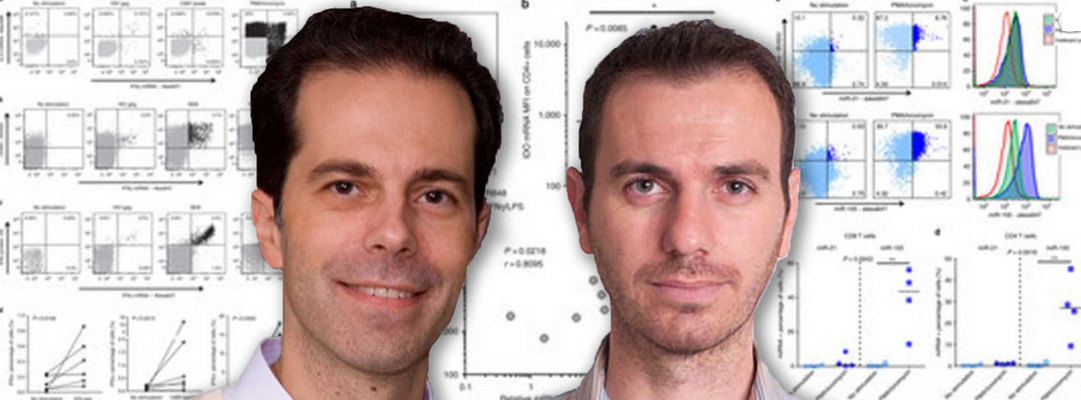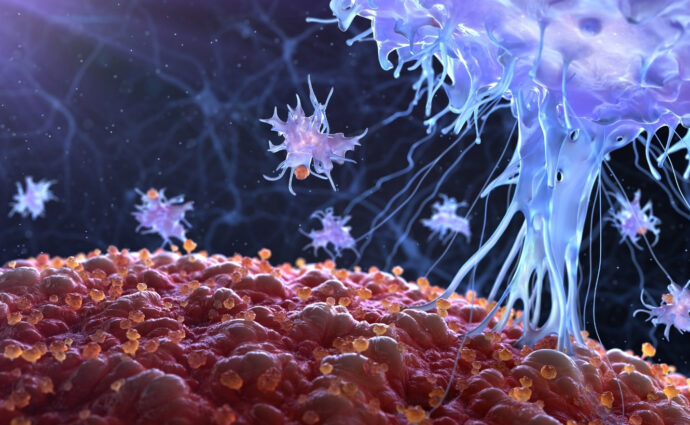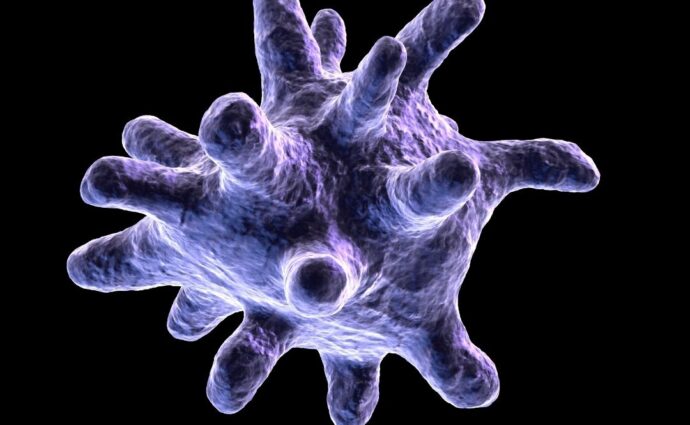Date: December 8, 2014 By:

Scientists from the Ragon Institute participate in the development of a novel technology to facilitate the study of immune responses at the single cell level.
BOSTON – In a manuscript published this month in Nature Communications, a group of scientists from the Ragon Institute of Mass General, MIT, and Harvard and the CHUM Research Center (CRCHUM) in Montreal led by Drs Filippos Porichis and Daniel Kaufmann describes a novel approach that allows high-throughput simultaneous analysis of gene-specific mRNAs and proteins and at the single cell level by flow cytometry.
This new technology developed in collaboration with the company Affymetrix uses gene-specific probes and a signal amplification system based on the “branched DNA” principle. The authors show that this novel flow-FISH (for “Fluorescent in situ hybridization”) technique is sensitive, specific and can be multiplexed with simultaneous detection of three different gene-specific RNAs. The results further demonstrate their ability to measure expression of genes critical for immune cells, such as cytokines, in white blood cells specifically targeting the HIV or CMV viruses. The authors also demonstrate the capacity to detect mRNAs for which flow antibodies against the corresponding proteins are poor or are not available.
“Combining a user-friendly protocol that has many similarities with standard antibody-staining procedures and data acquisition for flow cytometry, makes this assay a very attractive tool for immunology laboratories performing translational research” says Dr Porichis, first author of the manuscript.
One of the biggest obstacles for a more comprehensive understanding of how the immune system works in physiologic and pathologic conditions is the availability of novel technologies that push the barriers of current analytical tools. Single cell analysis is a rapidly growing field in biomedical research that is expanding our understanding of biologic characteristics of human diseases.
For several years, flow cytometry has been a major tool used by immunologists to characterize various immune cells. This approach exploits fluorescently labelled antibodies that bind to proteins expressed on different cell types. Important information about their phenotype and function can be obtained from the resulting staining patterns of immune cells. However, antibody-based characterization of cells with flow cytometry is restricted by the limited availability of antibodies that do not cover all the proteins expressed in cells. Furthermore, it does not investigate transcriptional events, i.e. regulation of gene expression at the RNA level. Although recent technological developments in molecular biology such as RNA-sequencing and microfluidic qRT-PCR platforms allow analysis of transcriptional expression in individual cells, such techniques require specialized skills and laborious methods such as single-cell sorting.
“This technology has broad potential applications in biomedical research” explains Dr Kaufmann, senior author of the study. “An additional advantage of this approach is the capacity to directly measure in heterogeneous cell populations non-coding RNAs such as microRNAs, whose critical regulatory roles on cell functions are increasingly recognized”
Web link: http://www.nature.com/ncomms/2014/141204/ncomms6641/full/ncomms6641.html
Pubmed link: http://www.ncbi.nlm.nih.gov/pubmed/25472703
Authors: Filippos Porichis, Meghan G. Hart, Morgane Griesbeck, Holly L. Everett, Muska Hassan, Amy E. Baxter, Madelene Lindqvist, Sara M. Miller, Damien Z. Soghoian, Daniel G. Kavanagh, Susan Reynolds, Brett Norris, Scott K. Mordecai, Quan Nguyen , Chunfai Lai and Daniel E. Kaufmann.
Financial Support: This study was supported by the National Institute of Allergy and Infectious Diseases of the National Institutes of Health (PO1 AI-080192 and UM1AI100663 (CHAVI-ID); D.E.K; 1R56AI095088-01 to DGK), the National Heart Lung and Blood Institute of the National Institutes of Health (RO1 HL-092565; D.E.K) and The Office of the Director, National Institutes of Health (NIH 1S10OD012027-01A1; Dr Frederic Preffer). D.E.K is supported by a Research Scholar Career Award of the Quebec Health Research Fund (FRQS). FP was supported by a fellowship grant of the Massachusetts General Hospital Executive Committee on Research and the Harvard Global Health Institute (HGHI). DGK was supported by a Grand Challenges Exploration award from Bill and Melinda Gates Foundation.
Scientist Spotlight of Dr. PorchiasAffymetrix eBioscience
Technology breakthrough reveals cellular transcription process – Health Canal

Their findings, to be published in Cell next month, reveal how the virus manipulates immune system processes to avoid destruction by natural killer (NK) cells, a type of white blood cell that is crucial for fighting viral infections.

The lab of the Ragon Institute faculty member Hernandez Moura Silva, PhD, recently published a review in Science Immunology regarding resident tissue macrophages (RTMs), shedding light on their multifaceted roles in organ health.

After three years off due to the COVID-19 pandemic, the Ragon-MIT course HST.434 returned this January to provide 24 students a once in a lifetime learning experience